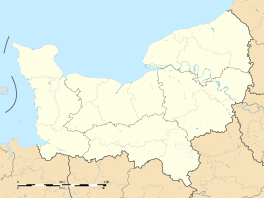Ste-Mere-Eglise
| Sainte-Mère-Église | ||
|---|---|---|

Church with Parachute Memorial
|
||
|
||
| Coordinates: 49°24′32″N 1°19′05″W / 49.4089°N 1.3181°WCoordinates: 49°24′32″N 1°19′05″W / 49.4089°N 1.3181°W | ||
| Country | France | |
| Region | Normandy | |
| Department | Manche | |
| Arrondissement | Cherbourg | |
| Canton | Carentan | |
| Intercommunality | Baie du Cotentin | |
| Government | ||
| • Mayor (2001–2008) | Jean-Paul Bouet | |
| Area1 | 32.08 km2 (12.39 sq mi) | |
| Population (2013)2 | 2,588 | |
| • Density | 81/km2 (210/sq mi) | |
| Time zone | CET (UTC+1) | |
| • Summer (DST) | CEST (UTC+2) | |
| INSEE/Postal code | 50523 /50480 | |
| Elevation | 1–41 m (3.3–134.5 ft) (avg. 34 m or 112 ft) |
|
|
1 French Land Register data, which excludes lakes, ponds, glaciers > 1 km² (0.386 sq mi or 247 acres) and river estuaries. 2Population without double counting: residents of multiple communes (e.g., students and military personnel) only counted once. |
||
1 French Land Register data, which excludes lakes, ponds, glaciers > 1 km² (0.386 sq mi or 247 acres) and river estuaries.
Sainte-Mère-Église is a commune in the Manche department in Normandy in northwestern France. On 1 January 2016, the former communes of Beuzeville-au-Plain, Chef-du-Pont, Écoquenéauville and Foucarville were merged into Sainte-Mère-Église.
Sainte-Mère-Église lies in a flat area of the Cotentin peninsula known locally as le Plain (as opposed to the standard French term la plaine). The Plain is bounded on the west by the Merderet River and by the English channel to the east, and by the communes of Valognes and Carentan to the north and south, respectively. Besides Sainte-Mère-Église, the Plain's other major town is Montebourg, and its coast includes Utah Beach.
Although most of the Cotentin Peninsula belongs to the Armorican Massif, the Plain is part of the Paris Basin. Argillaceous limestone from the Sinemurian contributes to the region's dairy product appellation (AOC) Isigny-Sainte-Mère, which it shares with Bessin. Horse breeding has long been practiced in the Plain, which is regarded as the cradle of the Anglo-Norman horse breed, the product of English stallions and mares from the Cotentin Peninsula.
Founded in the eleventh century, the earliest records (1080–1082) include the name Sancte Marie Ecclesia, Latin for "Church of St. Mary", while a later document written in Norman-French (1317) mentions Saincte Mariglise. The current French form of the name is ambiguous, with the additional meaning, "Holy Mother Church". The town was significantly involved in the Hundred Years' War as well as the Wars of Religion.
...
Wikipedia



